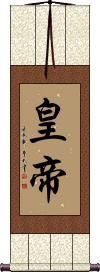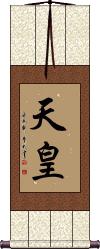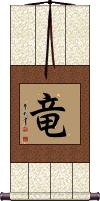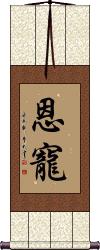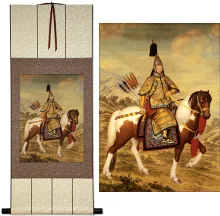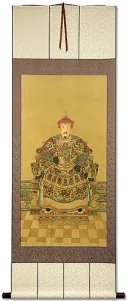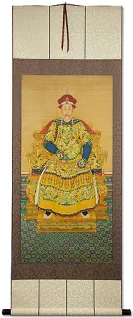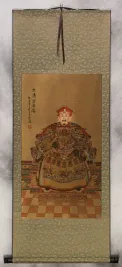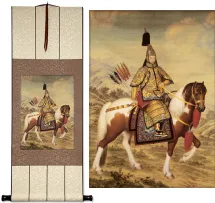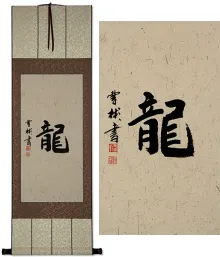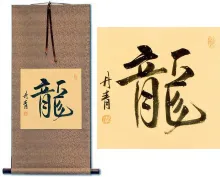Many custom options...
And formats...

Emperor in Chinese / Japanese...
Buy an Emperor calligraphy wall scroll here!
Personalize your custom “Emperor” project by clicking the button next to your favorite “Emperor” title below...
Emperor
Emperor
皇帝 means emperor in Chinese, Japanese, and old Korean.
From times of old, the emperors of Asia ruled under the authority of God himself. One definition of an emperor is a ruler put in power by God. This definition separates emperors from the various kings in Chinese history (although defining who is a king versus an emperor gets vague sometimes).
Occasionally, the emperor's wife was widowed, and she took the role of an empress until her death (see our entry for empress if that is what you are looking for).
Emperor of Japan
天皇 is the title of the Emperor of Japan.
This title is used in China, Korea, and Japan to refer specifically to the Emperor of Japan.
Dragon / Emperor Symbol
竜 is an alternate form of the dragon.
Still pronounced the same in Chinese, Japanese, and Korean.
This particular Kanji is often associated as an imperial symbol as well as representing the mythical Asian dragon. You may have seen it on the chest or flag of the emperor in old Japanese and Chinese movies.
Note: I would rate this as a non-universal alternate form. The other dragon character is by far more common, and universally understood.
We strongly recommend ![]() if you are looking for the symbol of dragon.
if you are looking for the symbol of dragon.
Grace / Favor
恩寵 means grace or favor in Chinese characters, Japanese Kanji, and old Korean Hanja.
In ancient China, this was a special favor bestowed by a ruler. It could also be the Emperor's generosity towards a favorite person or concubine.
This in-stock artwork might be what you are looking for, and ships right away...
Gallery Price: $119.00
Your Price: $65.88
Gallery Price: $200.00
Your Price: $79.88
Gallery Price: $200.00
Your Price: $66.88
Gallery Price: $200.00
Your Price: $66.88
Gallery Price: $108.00
Your Price: $59.88
Not the results for emperor that you were looking for?
Below are some entries from our dictionary that may match your emperor search...
| Characters If shown, 2nd row is Simp. Chinese |
Pronunciation Romanization |
Simple Dictionary Definition |
欽 钦 see styles |
qīn qin1 ch`in chin makoto まこと |
More info & calligraphy: Qin / Chin(personal name) Makoto Imperial; to respect, reverence. |
皇 see styles |
huáng huang2 huang sume; sumera; sube; subera すめ; すめら; すべ; すべら |
More info & calligraphy: Emperor(prefix) (archaism) (honorific or respectful language) divine; imperial; (female given name) Miyuki ruler |
秦 see styles |
qín qin2 ch`in chin shin; hatashin しん; はたしん |
More info & calligraphy: Qin / Chin / Tan / Yasushi(hist) Qin dynasty (of China; 221-207 BCE); Ch'in dynasty; (surname) Yasushi a fine strain of rice |
聖 圣 see styles |
shèng sheng4 sheng hijiri ひじり |
More info & calligraphy: The Saint(1) highly virtuous monk; (2) (honorific or respectful language) monk; (3) Buddhist solitary; (4) (See 高野聖・1) Buddhist missionary; (5) saint (i.e. a virtuous person); (6) (archaism) (honorific or respectful language) emperor; (7) (in form 〜の聖) master; expert; (female given name) Mina ārya; sādhu; a sage; wise and good; upright, or correct in all his character; sacred, holy, saintly. |
龍 龙 see styles |
lóng long2 lung riyou / riyo りよう |
More info & calligraphy: Dragon(out-dated kanji) (1) dragon (esp. a Chinese dragon); (2) naga; semi-divine human-cobra chimera in Hindu and Buddhist mythology; (personal name) Riyou A dragon, dragon-like, imperial; tr. for nāga, which means snake, serpent; also elephant, elephantine, serpent-like, etc., cf. 那. |
天恩 see styles |
tenon てんおん |
More info & calligraphy: Grace from Heaven / Grace from God |
天皇 see styles |
tiān huáng tian1 huang2 t`ien huang tien huang tennou / tenno てんのう |
More info & calligraphy: Emperor of JapanEmperor of Japan; (place-name) Tennou Deva-king; the Tang monk 道悟 Daowu of the 天皇 Tianhuang monastery at 荊州 Jingzhou. |
夫人 see styles |
fū ren fu1 ren5 fu jen fujin(p); bunin(ok); hashikashi(ok) ふじん(P); ぶにん(ok); はしかし(ok) |
More info & calligraphy: Fujin(1) (ふじん, はしかし only) (honorific or respectful language) wife; Mrs; madam; (2) (ふじん only) (archaism) wife of a nobleman (aristocrat, etc.); (3) (ふじん, ぶにん only) (archaism) consort of the emperor A wife; the wife of a king, i. e. a queen, devi. |
恩寵 恩宠 see styles |
ēn chǒng en1 chong3 en ch`ung en chung onchou / oncho おんちょう |
More info & calligraphy: Grace / Favorgrace; favour; favor |
海神 see styles |
hǎi shén hai3 shen2 hai shen watatsumi わたつみ |
More info & calligraphy: Neptune / Poseidonsea god; Poseidon; Neptune; (female given name) Watatsumi |
皇帝 see styles |
huáng dì huang2 di4 huang ti koutei / kote こうてい |
More info & calligraphy: Emperoremperor |
聖誕 圣诞 see styles |
shèng dàn sheng4 dan4 sheng tan shōtan |
More info & calligraphy: Christmasemperor's birthday |
蘇丹 苏丹 see styles |
sū dān su1 dan1 su tan suudan / sudan スーダン |
More info & calligraphy: Sultan(ateji / phonetic) (kana only) Sudan |
蚩尤 see styles |
chī yóu chi1 you2 ch`ih yu chih yu shiyuu / shiyu しゆう |
More info & calligraphy: God of Warcraft(archaism) Chinese god of war |
謝恩 谢恩 see styles |
xiè ēn xie4 en1 hsieh en shaon しゃおん |
More info & calligraphy: Shayne(n,vs,vi) (expression of) gratitude |
阿提拉 see styles |
ā tí lā a1 ti2 la1 a t`i la a ti la |
More info & calligraphy: Attila |
俞 see styles |
yú yu2 yü |
yes (used by Emperor or ruler); OK; to accede; to assent |
倖 幸 see styles |
xìng xing4 hsing yuki ゆき |
trusted; intimate; (of the emperor) to visit; variant of 幸[xing4] (female given name) Yuki |
卿 see styles |
qīng qing1 ch`ing ching kei / ke けい |
high ranking official (old); term of endearment between spouses (old); (from the Tang Dynasty onwards) term used by the emperor for his subjects (old); honorific (old) (pronoun) (1) (honorific or respectful language) (masculine speech) (archaism) (used to address someone of equal or lower status) you; (pronoun) (2) (honorific or respectful language) (archaism) (used by a ruler to address a subject) you; (given name) Akira you |
垚 see styles |
yáo yao2 yao |
variant of 堯|尧, legendary emperor Yao, c. 2200 BC; embankment |
夌 see styles |
líng ling2 ling |
to dawdle; the name of the father of the Emperor Yao |
㍽ see styles |
dà zhèng da4 zheng4 ta cheng taishou / taisho たいしょう |
Taishō, Japanese era name, corresponding to the reign (1912-1926) of emperor Yoshihito 嘉仁[Jia1 ren2] (hist) Taishō era (1912.7.30-1926.12.25); Taisho era; (personal name) Hiromasa |
奏 see styles |
zòu zou4 tsou sou / so そう |
to play music; to achieve; to present a memorial to the emperor (old) (See 奏する・そうする・1) report to the emperor; (female given name) Melody proclaims |
媧 娲 see styles |
wā wa1 wa |
surname Wa; sister of legendary emperor Fuxi 伏羲[Fu2xi1] |
崩 see styles |
bēng beng1 peng nadare なだれ |
to collapse; to fall into ruins; death of king or emperor; demise (female given name) Nadare |
帝 see styles |
dì di4 ti mikado みかど |
emperor emperor (of Japan); mikado; (female given name) Mikado Ruler, sovereign; translit. t. |
㍻ see styles |
píng chéng ping2 cheng2 p`ing ch`eng ping cheng heisei / hese へいせい |
Heisei, Japanese era name, corresponding to the reign (1989-2019) of emperor Akihito 明仁[Ming2 ren2] Heisei era (1989.1.8-2019.4.30); (place-name) Heisei |
㍾ see styles |
míng zhì ming2 zhi4 ming chih meiji / meji めいじ |
Meiji, Japanese era name, corresponding to the reign (1868-1912) of the Meiji emperor (hist) Meiji era (1868.9.8-1912.7.30); (p,s,g) Meiji |
㍼ see styles |
zhāo hé zhao1 he2 chao ho shouwa / showa しょうわ |
Shōwa, Japanese era name, corresponding to the reign (1925-1989) of emperor Hirohito 裕仁[Yu4 ren2] (1) (hist) Shōwa era (1926.12.25-1989.1.7); (adjectival noun) (2) (colloquialism) reminiscent of the Shōwa era; Shōwa-nostalgic; old-fashioned; quaint; old-school; (given name) Terukazu |
朔 see styles |
shuò shuo4 shuo saku さく |
beginning; first day of lunar month; north (1) {astron} new moon; (2) first day of the lunar month; (3) (hist) next year's calendar and decrees (in ancient China; distributed by the Emperor at year's end); (given name) Hajime |
Click here for more emperor results from our dictionary
The following table may be helpful for those studying Chinese or Japanese...
| Title | Characters | Romaji (Romanized Japanese) | Various forms of Romanized Chinese | |
| Emperor | 皇 | kou / ko | huáng / huang2 / huang | |
| Emperor | 皇帝 | koutei / kotei | huáng dì / huang2 di4 / huang di / huangdi | huang ti / huangti |
| Emperor of Japan | 天皇 | ten nou / tennou / ten no | tiān huáng tian1 huang2 tian huang tianhuang | t`ien huang tienhuang tien huang |
| Dragon Emperor Symbol | 竜 | ryuu / tatsu ryu / tatsu | lóng / long2 / long | lung |
| Grace Favor | 恩寵 恩宠 | on chou / onchou / on cho | ēn chǒng / en1 chong3 / en chong / enchong | en ch`ung / enchung / en chung |
| In some entries above you will see that characters have different versions above and below a line. In these cases, the characters above the line are Traditional Chinese, while the ones below are Simplified Chinese. | ||||
Successful Chinese Character and Japanese Kanji calligraphy searches within the last few hours...

